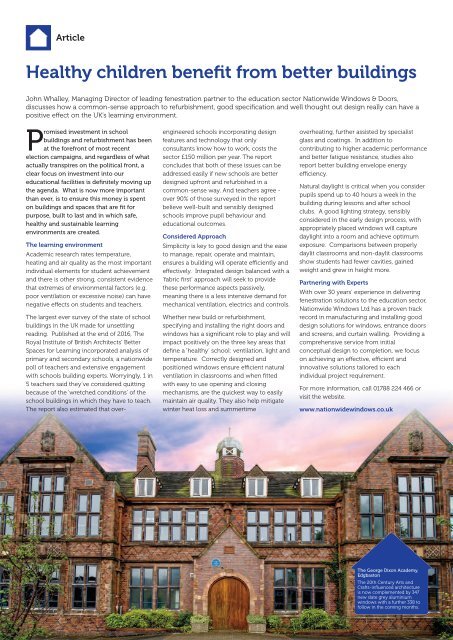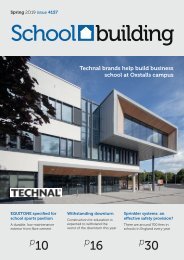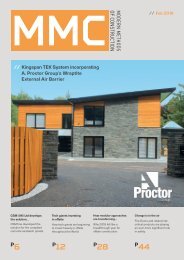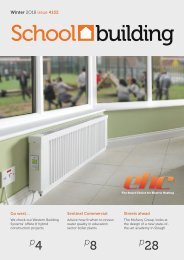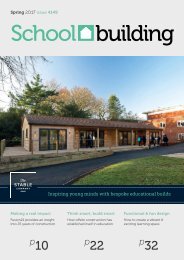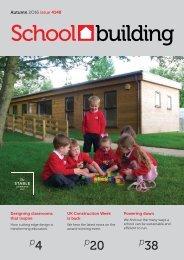SB 4150 Web
You also want an ePaper? Increase the reach of your titles
YUMPU automatically turns print PDFs into web optimized ePapers that Google loves.
Article<br />
Healthy children benefit from better buildings<br />
John Whalley, Managing Director of leading fenestration partner to the education sector Nationwide Windows & Doors,<br />
discusses how a common-sense approach to refurbishment, good specification and well thought out design really can have a<br />
positive effect on the UK’s learning environment.<br />
Promised investment in school<br />
buildings and refurbishment has been<br />
at the forefront of most recent<br />
election campaigns, and regardless of what<br />
actually transpires on the political front, a<br />
clear focus on investment into our<br />
educational facilities is definitely moving up<br />
the agenda. What is now more important<br />
than ever, is to ensure this money is spent<br />
on buildings and spaces that are fit for<br />
purpose, built to last and in which safe,<br />
healthy and sustainable learning<br />
environments are created.<br />
The learning environment<br />
Academic research rates temperature,<br />
heating and air quality as the most important<br />
individual elements for student achievement<br />
and there is other strong, consistent evidence<br />
that extremes of environmental factors (e.g.<br />
poor ventilation or excessive noise) can have<br />
negative effects on students and teachers.<br />
The largest ever survey of the state of school<br />
buildings in the UK made for unsettling<br />
reading. Published at the end of 2016, The<br />
Royal Institute of British Architects’ Better<br />
Spaces for Learning incorporated analysis of<br />
primary and secondary schools, a nationwide<br />
poll of teachers and extensive engagement<br />
with schools building experts. Worryingly, 1 in<br />
5 teachers said they’ve considered quitting<br />
because of the ‘wretched conditions’ of the<br />
school buildings in which they have to teach.<br />
The report also estimated that overengineered<br />
schools incorporating design<br />
features and technology that only<br />
consultants know how to work, costs the<br />
sector £150 million per year. The report<br />
concludes that both of these issues can be<br />
addressed easily if new schools are better<br />
designed upfront and refurbished in a<br />
common-sense way. And teachers agree -<br />
over 90% of those surveyed in the report<br />
believe well-built and sensibly designed<br />
schools improve pupil behaviour and<br />
educational outcomes.<br />
Considered Approach<br />
Simplicity is key to good design and the ease<br />
to manage, repair, operate and maintain,<br />
ensures a building will operate efficiently and<br />
effectively. Integrated design balanced with a<br />
‘fabric first’ approach will seek to provide<br />
these performance aspects passively,<br />
meaning there is a less intensive demand for<br />
mechanical ventilation, electrics and controls.<br />
Whether new build or refurbishment,<br />
specifying and installing the right doors and<br />
windows has a significant role to play and will<br />
impact positively on the three key areas that<br />
define a ‘healthy’ school: ventilation, light and<br />
temperature. Correctly designed and<br />
positioned windows ensure efficient natural<br />
ventilation in classrooms and when fitted<br />
with easy to use opening and closing<br />
mechanisms, are the quickest way to easily<br />
maintain air quality. They also help mitigate<br />
winter heat loss and summertime<br />
overheating, further assisted by specialist<br />
glass and coatings. In addition to<br />
contributing to higher academic performance<br />
and better fatigue resistance, studies also<br />
report better building envelope energy<br />
efficiency.<br />
Natural daylight is critical when you consider<br />
pupils spend up to 40 hours a week in the<br />
building during lessons and after school<br />
clubs. A good lighting strategy, sensibly<br />
considered in the early design process, with<br />
appropriately placed windows will capture<br />
daylight into a room and achieve optimum<br />
exposure. Comparisons between properly<br />
daylit classrooms and non-daylit classrooms<br />
show students had fewer cavities, gained<br />
weight and grew in height more.<br />
Partnering with Experts<br />
With over 30 years’ experience in delivering<br />
fenestration solutions to the education sector,<br />
Nationwide Windows Ltd has a proven track<br />
record in manufacturing and installing good<br />
design solutions for windows, entrance doors<br />
and screens, and curtain walling. Providing a<br />
comprehensive service from initial<br />
conceptual design to completion, we focus<br />
on achieving an effective, efficient and<br />
innovative solutions tailored to each<br />
individual project requirement.<br />
For more information, call 01788 224 466 or<br />
visit the website.<br />
www.nationwidewindows.co.uk<br />
The George Dixon Academy,<br />
Edgbaston<br />
The 20th Century Arts and<br />
Crafts-influenced architecture<br />
is now complemented by 347<br />
new slate grey aluminium<br />
windows with a further 338 to<br />
follow in the coming months.


